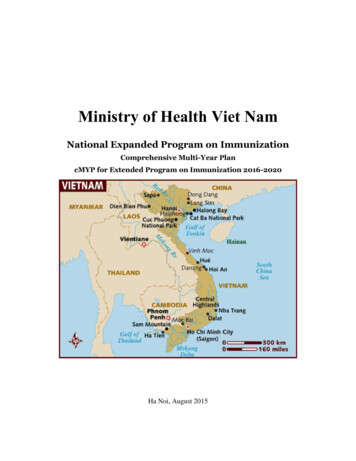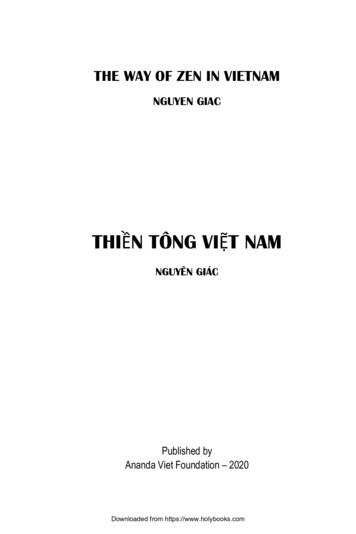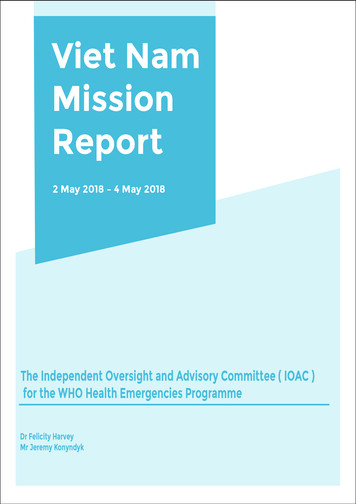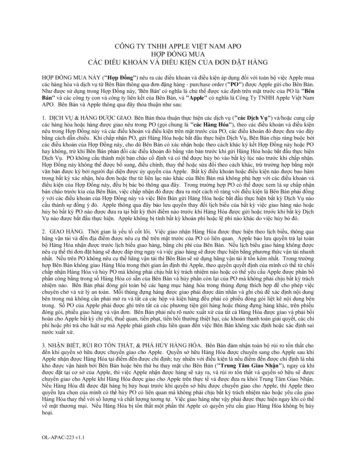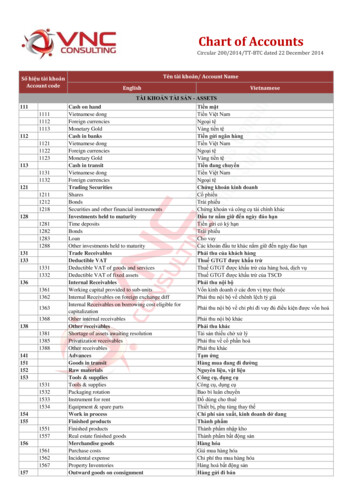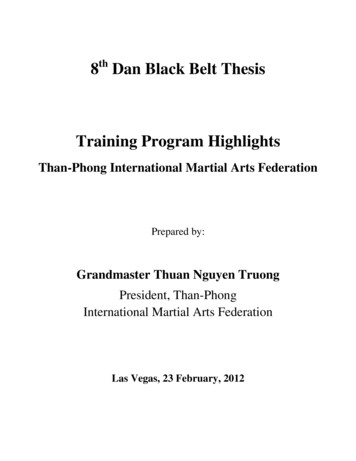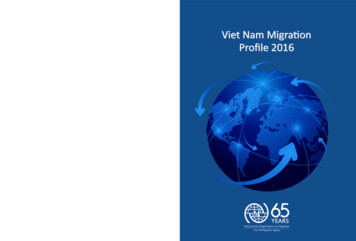
Transcription
Viet Nam MigrationProfile 2016Taiwan Provinceof the People’sRepublic of ChinaViet Nam Migration Profile 2016International Organization for Migration304 Kim Ma Ba Dinh Ha Noi Viet NamTel: (84.4) 3850.0100 Fax: 3726 5519E-mail: hanoi@iom.int Internet: http://www.iom.int.vn
The opinions expressed in the publication are those of the authors and do not necessarily reflectthe views of the International Organization for Migration (IOM). The designations employed andthe presentation of material throughout the report do not imply the expression of any opinionwhatsoever on the part of IOM concerning the legal status of any country, territory, city or area, orof its authorities, or concerning its frontiers or boundaries.IOM is committed to the principle that humane and orderly migration benefits migrants and society.As an intergovernmental organization, IOM acts with its partners in the international communityto: assist in meeting the operational challenges of migration; advance understanding of migrationissues; encourage social and economic development through migration; and uphold the humandignity and well-being of migrants.Publisher:International Organization for Migration304 Kim Ma Ba Dinh Ha Noi Viet NamTel: (84.4) 3850.0100Fax: 3726 5519E-mail: hanoi@iom.intWebsite: www.iom.int.vn 2017 International Organization for Migration (IOM)All rights reserved. No part of this publication may be reproduced, stored in a retrieval system,or transmitted in any form or by any means, electronic, mechanical, photocopying, recording, orotherwise without the prior written permission of the publisher.57 17
Viet Nam MigrationProfile 2016Ha Noi, August 2017
FOREWORDReflecting global trends, greater numbers of Vietnamese citizens aremigrating with millions of departures each year to a broad variety of countriesand territories. However, the opportunities and benefits for Vietnamese citizens’safe and legal migration have not been properly evaluated. For migration to bean appropriate choice for citizens, coherent government policy and close Statemanagement and coordination are needed, together with cooperation from allstakeholders.To build a comprehensive people-centred policy to address migration fromViet Nam, the Consular Department of the Ministry of Foreign Affairs took thelead in the development of the Viet Nam Migration Profile 2016, with financialand technical support from the International Organization for Migration (IOM).Dr Vu Manh Loi, from the Institute of Sociology, Viet Nam Academy of SocialSciences (VASS), compiled this report with support from an advisory panel,comprised of migration experts from relevant ministries and branches.The Viet Nam Migration Profile 2016 was based on the successful Reviewof Vietnamese Migration Abroad* report released in 2011. This earlier reportsought to provide a general overview on international migration from Viet Namand also sought to contribute to the development of a comprehensive migrationpolicy suitable to the context and specific features of Viet Nam.The relationship between migration and development, as well as thereasons for migration and the challenges faced during the process of migration,are presented in detail throughout this report based on an analysis of informationand data provided by relevant agencies and branches of government. Theanalysis, comments and assessments of data focus on the period 2012–2016,and readers can gain a valuable overview of Viet Nam’s role in the internationalmigration process.Sincere thanks goes to the participating ministries, branches, institutes,academies and research centres for their enthusiastic support during the entiredevelopment process of this report. Members of the advisory panel, expertsand scholars are also acknowledged for their valuable comments and advice,especially Dr Vu Manh Loi for the compilation of this report.* The Consular Department took the lead, in coordination with the IOM Mission Office in Ha Noi and VASSteam, to develop the report with financial support from the European Union.Viet Nam Migration Profile 2016iii
The Consular Department would also like to take this opportunity toexpress its sincere thanks to Mr David Knight, Chief of Mission, and Mr NguyenQuoc Nam, Programme Officer from the IOM Mission Office in Ha Noi, for theirclose and effective coordination and cooperation during the development andproduction of this Viet Nam Migration Profile 2016. Thanks must also go to theIOM Development Fund for the financial support to facilitate the developmentof this profile.Consular Department, Ministry of Foreign AffairsivViet Nam Migration Profile 2016
CONTENTSForeword.iiiList of tables. viList of figures. viiList of acronyms. ixExecutive summary. xi1. Background.11.1.1.2.1.3.1.4.Global migration . 1Socioeconomic background of Viet Nam . 6Migration profile. 8Objectives, methodology, sources of information,limitations of the report. 111.4.1. Objectives. 111.4.2. Terminology and indicators of internationalmigration and sources of information . 111.5. Information collection methodology and report limitations. 142. Scale and trends of Vietnamese migration abroad .172.1.2.2.2.3.2.4.2.5.2.6.Entry–exit situation of Vietnamese by years. 17Vietnamese labour migration abroad. 21Migration for study. 31Marriage migration. 38International child adoption. 44Human trafficking. 483. Motivating factors and impacts of international tivating factors for international labour migration. 55Motivating factors for migration for study overseas. 56Motivating factors for marriages with foreign nationals . 57Motivating factors for international child adoption . 57Motivating factors for migration relating to human trafficking. 58Impacts on migrants. 58Impacts on families. 60Impacts on sending countries. 63Impacts on destination communities and integrationof migrant workers at destination. 68Viet Nam Migration Profile 2016v
4. International migration governanceand international cooperation.714.1.4.2.4.3.4.4.4.5.Institution and policies on international labour migration. 71Policies and regulations on international migration for study. 75Regulations and policies on marriages with foreign nationals. 76Regulations and policies on international child adoption. 77Regulations on Migration Relating to Human Trafficking. 785. Conclusion and recommendations.815.1. Concluding remarks. 815.2. Recommendations. 83Annex: List of consultants.89References.91LIST OF TABLESTable 1.Table 2.Annual entry–exit trends of Vietnamese citizens, 2012–2016. 18Vietnamese migrant workers sent abroad and receivingcountries/territories by year of departure, 2012–2016. 22Table 3. Top 15 receiving destinations for Vietnameseworkers, 2012–2016 . . 22Table 4. Vietnamese migrant workers working abroadand average monthly incomes, 2014. 25Table 5. Vietnamese migrant workers in foreign destinationsfrom top 25 labour-sending provinces, 2012–2016. 26Table 6. Number of exits–entries with travel documentsthrough land borders, 2012–2016. 27Table 7. Number of annual exits–entries by Vietnamesethrough Huu Nghi border checkpoint. 28Table 8. State-sponsored Vietnamese students departing/returningin 2016 by destination countries/territories and sex. 31Table 9. Gender -based division of Vietnamese marriageswith foreign nationals by year. 39Table 10. Division of Vietnamese nationals marryingforeign nationals by places of origin, 2008–2016. 40Table 11. Vietnamese marrying Americans in20 major provinces, 2013–2016. 41viViet Nam Migration Profile 2016
Table 12. Vietnamese marrying Taiwanese citizens in20 major provinces, 2013–2016. 42Table 13. Vietnamese marrying Koreans in 10 major provinces, 2013–2016. 42Table 14. Vietnamese marrying Chinese in 20 provinces/cities, 2013–2016. 43Table 15. Children adopted by foreign nationals by destination, 2012–2016. 45Table 16. Registered international child adoption in top 15provinces, 2012–2016. 46Table 17. Total number of trafficking cases,traffickers and victims, 2008–2016. 49LIST OF FIGURESFigure 1.Figure 2.Figure 3.Figure 4.Figure 5.Figure 6.Figure 7.Figure 8.Figure 9.Figure 10.Figure 11.Figure 12.Figure 13.Figure 14.Figure 15.Figure 16.Number of international migrants accordingto origin and destination, 2015. 3Twenty countries/territories with highest numbersof international immigrants (millions). 4Twenty countries/territories with highest numbersof citizens living abroad (millions). 5Expanded migration model. 9Percentage of exits–entries by females, 2012–2015. 18Percentage of exits by females by age group, 2012–2015. 19Percentage of border crossings by sex and age group, 2015. 20Number of US visas granted to Asian country citizens, 1997 –2014. 21Percentage of Vietnamese female migrant workersin top 15 receiving destinations, 2012–2016. 24Percentage of female students at differenteducation levels among students goingoverseas to study, 2015–2016. 33Percentage of female students going abroad to study under Statescholarship programmes, 2015–2016 . 33Vietnamese students overseas (secondary and higher education)in top Vietnamese student-receiving destinations, 2013. 34International students from top 15 places of origin(except China and India) granted US visas, 2012–2016(Data on charts for 2016). 35Distribution of Vietnamese students in theUnited States regarding majors in 2014–2015 school year. 36Percentages of international child adoptionby sex and age, 2014–2016. 47Percentage of trafficking survivors by sex,ethnic group and marriage status, 2008–June 2013 . 50Viet Nam Migration Profile 2016vii
Figure 17. Percentage of trafficked victims by education levels,employment and well-being status, 2008–mid 2013. 51Figure 18. Households’ standards of living pre- and post-migration. 61Figure 19. Percentage of households receiving remittancesfrom international migrants. 63Figure 20. Remittances of Vietnamese overseas by time, 2003–2016. 64Figure 21. Vietnamese migrants’ remittance flows to Viet Nam in 2015. 65Figure 22. Remittances of several countries, 2015. 65Figure 23. “Brain drain”: foreign nurses and doctorsworking in OECD countries, 2000–2001 and 2010–2011. 67viiiViet Nam Migration Profile 2016
LIST OF ACRONYMSAPECASEANASEMDoLABAsia-Pacific Economic CooperationAssociation of Southeast Asian NationsAsia-Europe MeetingDepartment for Overseas LabourDoLISAFDIFTAGDPGSOICEFILOIOMIOM MRTCDepartment of Labour, Invalids and Social AffairsForeign direct investmentFree trade agreementGross domestic productGeneral Statistics OfficeInternational Consultants for Education and FairsInternational Labour OrganizationInternational Organization for MigrationMigration Research and Training Centre of the InternationalOrganization for Migration in Republic of KoreaJapan Student Services OrganizationMinistry of Culture, Sports and TourismMinistry of Education and TrainingMinistry of Foreign AffairsMinistry of JusticeMinistry of Labour, Invalids and Social AffairsMinistry of National DefenceMinistry of Planning and InvestmentMinistry of Public SecurityMalaysia Healthcare Travel CouncilMemorandum of understandingOfficial Development AssistanceOrganization for Economic Co-operation and DevelopmentUnited Nations Department of Economic and Social AffairsUnited Nations Development ProgrammeUnited Nations International Children’s Emergency FundUnited Nations Office on Drugs and ODAOECDUN DESAUNDPUNICEFUNODCViet Nam Migration Profile 2016ix
USDVASSVNDWTOxUnited States dollarViet Nam Academy of Social SciencesViet Nam dongWorld Trade OrganizationViet Nam Migration Profile 2016
EXECUTIVE SUMMARYFollowing the landmark Review of Vietnamese Migration Abroad,conducted and published in 2011, this Viet Nam Migration Profile 2016 wasproduced to provide up-to-date evidence on the situation of internationalmigration and the relationship between migration and development in VietNam. Its findings can make meaningful contributions to policy planning, enhancecapacity in data collection of statistics and information sharing among relevantagencies/organizations.Situation of international migrationDuring 2012–2016, the number of Vietnamese citizens exiting andentering Viet Nam rose during 2012–2015 and decreased in 2015–2016. In2016, approximately 6 million people exited and nearly 6 million people enteredthe country. If the number of estimated unofficial entries and exits throughland borders is considered, the overall figure of Vietnamese people exiting(and entering) the country annually could reach more than 9 million people –approximately 10 per cent of the national population. Those who exited thecountry were often in the most active working age group of 20–40 years, withwomen having a slightly lower percentage of outmigration than men.International departures for livelihood purposes is the most popular formof migration for Vietnamese, including those who work abroad under fixedterm contracts and self-funded migration of workers to neighbouring countriesthrough land borders. These two types of migration were found to have climbedduring 2012–2016, with the number of migrants under fixed-term contractsabroad having reached 126,296 during 2016, with 28 countries/territories asdestinations. Just one third of migrants who moved overseas under fixed-termcontracts during 2012–2016 were women, while residents from north-centralNghe An and northern provinces constituted the majority of migrant workersunder fixed-term contracts. The top destinations for fixed-term contractedVietnamese workers were Taiwan Province of the People’s Republic of China,Japan, Republic of Korea, Malaysia and Saudi Arabia. Generally, migrants workingabroad under fixed-term contracts enjoy higher salaries than for similar types ofwork domestically.Viet Nam Migration Profile 2016xi
Many self-funded migrants, who pass through borders to neighbouringcountries for work, travel with legal documents. However, a considerablepercentage unofficially crossed borders via overland trails. These irregularmigrants are more vulnerable and are shown to experience threats, lack of legalprotection and exploitation. Such migrants might easily fall victim to humantraffickers or be subject to administrative fines by authorities on both sides ofthe border.Migration for study is common among school and college-age students.Most migrant students are self-funded and not included in statistics gatheredby the Ministry of Education and Training (MoET) for policymaking. The numberof students studying abroad under scholarships from the State budget oragreements between the Government of Viet Nam and foreign governmentsmanaged by the MoET only accounted for a small proportion of educationmigrants. In 2016, some 1,464 MoET-managed students went abroad to study in41 countries/territories, and 737 students returned after completion of studies.The main receiving countries of Government of Viet Nam-supported students in2016 were the Russian Federation (722 students), Australia (107), France (93),Hungary (67), Germany (52), China (51), Japan (51), United Kingdom (44), LaoPeople’s Democratic Republic (41), the United States (32), New Zealand (27),Cambodia (25), Ukraine (22) and Belgium (20). Other countries had less than 20Vietnamese students each.The number of self-funded students is significant and increased during2012–2016. In 2015, Viet Nam had the sixth highest number of students inthe United States (17,875 students). Business administration was the mostpopular major for Vietnamese students in the United States, with one thirdof all Vietnamese students in the country during the 2014–2015 school yearhaving studied business administration as a major. Other popular majors wereengineering (8.9%), English (8.6%), mathematics and computer science (8.3%)and physics/biology (7.2%). Only 5.1 per cent of students tackled social sciencesand 1.4 per cent humanities, while 4 per cent of students chose medical majors.In Japan, there were up to 38,880 Vietnamese students during 2015, makingViet Nam the second largest sender of students behind China. There werealso approximately 45,000 Vietnamese trainees in Japan. In New Zealand, thenumber of Vietnamese students was 17,222 in 2015; in Australia, it was 10,282and 5,618 in Canada. Vietnamese students also studied in a range of othercountries; however, statistics are limited or non-existent. Overall, it is estimatedthat more than 100,000 Vietnamese were studying abroad during 2016, and thisfigure, as forecasted, will continue to increase as the country further integratesinto the global community.xiiViet Nam Migration Profile 2016
Another type of international migration stems from marriages betweenVietnamese and foreign nationals. During 2012–2016, marriages with foreignnationals were recorded in all 63 provinces and cities nationwide. In 2016, 16,223Vietnamese citizens (85% female) married foreigners. Overall, the percentage ofwomen marrying foreigners has decreased, while that of men increased. TheUnited States, Republic of Korea, Taiwan Province of the People’s Republic ofChina, China and Australia had the most significant numbers of citizens marryingVietnamese nationals. International migration due to adoption of Vietnamesechildren by foreign nationals was also commonplace. In 2016, 551 cases ofinternational child adoption were recorded across 46 provinces/cities. The totalnumber of children adopted by foreign nationals during 2012–2016 amountedto 2,312 cases. Most adopted children were aged 1–5 years, with a slightly higheradoption rate for girls than boys – 53.3 per cent of total adoptions in 2014, 53.6per cent in 2015 and 52.3 per cent in 2016. France received the highest numberof adopted Vietnamese children during the past decade, followed by Italy,Taiwan Province of the People’s Republic of China, Spain, Canada, Republic ofKorea, Ireland, Sweden, Germany and Denmark.Human trafficking, which has become commonplace in Viet Nam sincethe 1990s, is another cause of international migration. According to the SteeringCommittee 138/CP, during 2008–2016, Viet Nam detected 3,897 cases of humantrafficking with 6,188 traffickers and identified 8,366 survivors of trafficking,more than 85 per cent of whom were women and children. Nearly 90 per centof transnational trafficking cases took place across Viet Nam’s borders withCambodia, China and Lao People’s Democratic Republic, with 70 per cent of allcases involving crossings into China. In general, human trafficking has becomemore complex and has taken more diverse forms, with commercial sexualexploitation and forced marriage the most common causes. Trafficking in infants,fetuses and for removal of organs is also recurrent. The number of discoveredsurvivors has generally tended to increase, reaching approximately 1,000persons per year during 2012–2016. However, it must be noted that the figure islikely much higher, as victims of trafficking often choose not to disclose or reporttheir situation to authorities or seek assistance from authorities; however, thiscrime has been detected in all of Viet Nam’s 63 provinces/cities, especially alongViet Nam’s borders with Cambodia, China and Lao People’s Democratic Republic.Impact of international migrationThe impact of international migration from Viet Nam is diverse andmultidimensional with positive and negative effects on migrants themselves,their families and communities of origin and destination. Positive impacts forViet Nam Migration Profile 2016xiii
migrants include opportunities for employment and higher income, improvededucation, skills and qualifications, as well as to learn foreign languages. Forfamilies in Viet Nam, international migrants are important sources of financialsupport as a result of remittances sent home. Most often, family members investthese funds in house repairs or construction, family business start-ups, children’seducation, health care or to facilitate other family members to migrate overseasfor employment.For communities in origin and destination countries, internationalmigration of workers is seen to have positive impacts overall. Internationalmigration reduces employment pressures on the local labour market, andremittances help local communities and countries generate more investmentresources for development.However, international migration, particularly irregular migrationoccurring outside legal pathways, also has negative implications for migrants,their families, communities and countries. Irregular migrants or those who firstmigrate regularly, but then stay irregularly overseas are generally not protectedby laws and can easily become victims of exploitation, abuse and humantrafficking. Many migrant workers also face economic risks when employersencounter economic hardships or do not comply with previously signed labourcontracts. For families, long periods of separation between husbands and wives,parents and children have unintended consequences that impact negatively onthe spousal relationship, care, health and education of children, as well as carefor the elderly.In response, appropriate measures and institutions must be put in placeto protect the legitimate rights and interests of all international migrants, tominimize risks and create conditions for international migration to make bettercontributions at individual, family and country levels.Governance and international cooperationThe Government of Viet Nam has instituted numerous policies andprogrammes to support and promote international labour migration and overseasstudy, as well as create supportive conditions for marriages to foreign nationalsand child adoption in compliance with international legislation. In addition,the Government has a number of policies and measures to deter, prevent andreduce the harmful effects of irregular migration, especially cross-border humantrafficking. The Government of Viet Nam has actively promoted internationalcooperation with relevant countries to ensure a safe migration environmentxivViet Nam Migration Profile 2016
and protect migrants’ rights and interests. However, current institutionalarrangements, agencies and policies on international migration have displayeddistinct limitations in tracking, monitoring and managing international migrationprocesses.Recommendations The State is encouraged to appoint a migration management agency toact as a focal point to develop a database on international migration andperiodical migration profiles for management and development. Themost appropriate agency for this purpose is the Ministry of Foreign Affairs(MoFA). Ministries and branches, within their areas of responsibility and functions,should review current international migration policies and institutions tooptimize migration procedures in Viet Nam. Optimization would includereduced migration costs and enhanced services to existing migrants andpotential ones. At the same time, the control of border entries and exitsshould be better managed through the development of an electronicdatabase to collect statistics according to set criteria, such as age, gender,place(s) of departure/destination and purpose(s) of migration, if possible. MoFA is recommended to instruct Viet Nam’s diplomatic representativesabroad to effectively protect the rights and legitimate interests ofVietnamese citizens overseas. The Ministry of Labour, Invalids and Social Affairs is encouraged to continueits review policies relating to contracted outward labour migration andrelated management mechanisms to manage this migration flow. Itshould also strengthen the supervision and evaluation of labour-sendingenterprises to ensure overseas labour migration activities are safe andconvenient with reduced costs and the rights and interests of workers,sending enterprises and employers are well protected. MoET is recommended to develop and propose an international educationintegration strategy to the Government to strengthen participation in theinternational education market through creation of favourable conditionsto grow the market domestically and encourage Vietnamese to studyabroad. Ministry of Public Security to continue its review of migration mechanismsand policies to create favourable conditions for Vietnamese citizens to goabroad for work, study, tourism and other legitimate purposes. Ministry of National Defence is encouraged to enhance measures toprevent different forms of irregular migration through land and seaborders.Viet Nam Migration Profile 2016xv
Ministry of Justice could closely cooperate with ministries, branches andlocal authorities to ensure marriages to foreign nationals and internationalchild adoption are lawfully carried out, and cases of deception and abuseleading to trafficking in persons are minimized. Ministry of Information and Communication should enhance informationand communications channels for dissemination of information on policies,regulations and practices related to Vietnamese migration abroad. Ministries/sectors and other social organizations have important roles insupporting these activities, as well as in the development of inter-agencymechanisms for international migration research, policy implementationand management. Information sharing and public awareness raising onthe benefits and risks of international migration must also be enhanced.xviViet Nam Migration Profile 2016
1. BACKGROUND1.1. Global migrationThe International Organization for Migration’s (IOM) World MigrationReports of 2013 and 2015 (IOM, 2015; IOM, 2013) stated that migrationin general and international migration in particular were commonplace indeveloping and developed countries. Migrants from developing countries wereoften younger aged, and males migrated more than females. Most migrantstravelled for improved livelihoods and to send remittances to support families.Those who migrated for educational purposes often went from developingcountries to developed ones, but a reverse trend had become more evident aspeople migrated to seek economic opportunities, study, retire or
International Organization for Migration 304 Kim Ma Ba Dinh Ha Noi Viet Nam Tel: (84.4) 3850.0100 Fax: 3726 5519 . the Consular Department of the Ministry of Foreign Affairs took the . United States regarding majors in 2014-2015 school year.36 Figure 15. Percentages of international child adoption by sex and age, 2014 .

